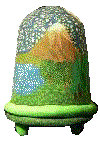How do I do it????
(what follows is a generic
response. If you have specific questions e-mail me)
Most of the lamps pictured on this web site are made entirely of polymer clay. I primarily use Sculpey III because it's easy to work with, and passes light well at workable thickness.
The illuminated part (the top) of the night lights are built in two layers A base layer of translucent clay, and then the color layer on top of that.
- I
wrap a form (usually a 6oz. drinking glass) with aluminum foil, (though
I've heard that pantyhose also work well). Make sure that the foil is
flattened as much as possible, so that there are no ridges standing
up that will cut into the clay.
-
I generally roll the translucent out to a #1 or #2 on my pasta machine.
This provides a sturdy base fpr the corored layer to come. It's a good
idea to bake the translucent layer and the form before applying the
color layer, as this will help to maintain an even thickness when you
work with it later. (also if any defects turn up in the base layer,
you can find them before investing too much work in the color layer.
- I apply slices of cane to form my little pictures. Caning isn't the only way to make a graphic, but I almost invariably build the images from cane slices. You can simply press soft clay onto the form, and smooth it down. When you bake it again the new clay will fuse to the old. If you find that the details of your cane slice are smudging as you press the slice onto the base layer, you can try covering them with Saran® wrap while you press them into place (this also reduces fingerprints.
The night light bases are 4.5" disks of clay with a 5/8" hole through the center. They have three feet on the bottom and a circular ridge rising from the top about 1/2" in from the lip. The top of the nightlight fits over the ridge, which keeps the top in place, and blocks light from shining out around the lower edge. As for the wiring, I use the socket from large bulb ( 4 or 7 watt, not mini) Christmas lights. I remove the wire from the base of the socket (on the lights that I buy this means popping out a small wedge) and replace it with 18 gauge zip cord that I get in 100' rolls from Radio Shack. The plug is a clip-on type (also from RS) that clamps on to the other end of the wire. I usually put a small rotary switch (RS again) on the cord as well. The socket protrudes through the hole so that the wire and bottom of the socket hang out the bottom of the clay disk, and the lip of the socket and the glass part of the bulb are on top and are hence inside the top part of the lamp.
The bases are made of scrap clay, with slices of complimentary (to the top (hopefully)) cane covering the visible portion. I use low wattage night light bulbs so that overheating (and the resultant toxic fumes) are not a problem, but larger pieces could be made for fluorescent bulbs or with thought toward cooling ventilation (open top and bottom). I find that the 6" tall night light makes for a manageable project.
If you're going to build a pictorial piece I recommend doing some experimenting with your clay's translucency for different colors at different thickness'. I use Sculpey III almost exclusively for my image canes, and a Sculpey/fimo mix for the translucent layer, because colored fimo stays pretty much opaque until it's VERY thin. Cernit I don't know about.
To discover more about
working with polymer clay
get Nan Roche's book, THE
NEW CLAY.
now go back and look
at the lamps

